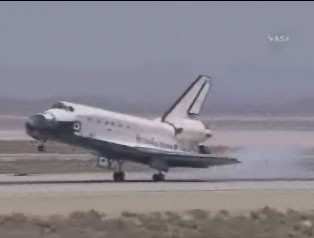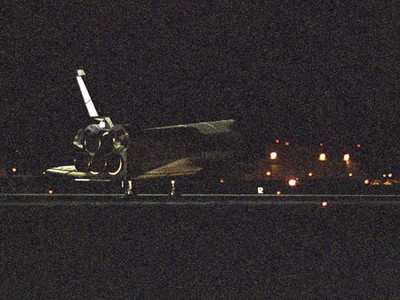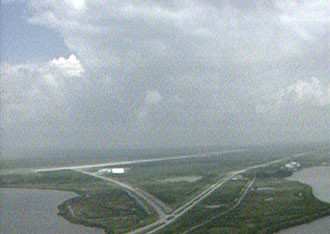Back On Earth, Still A Bit Far From Home
 ANN REALTIME REPORTING
06.22.07 1549 EDT: Touchdown! Moments ago, the space
shuttle Atlantis came to a stop on runway 22 at Edwards Air Force
Base, bringing to close a successful 13 day, 20 hour, and roughly
11-minute flight... with the textbook definition of a perfect
landing.
ANN REALTIME REPORTING
06.22.07 1549 EDT: Touchdown! Moments ago, the space
shuttle Atlantis came to a stop on runway 22 at Edwards Air Force
Base, bringing to close a successful 13 day, 20 hour, and roughly
11-minute flight... with the textbook definition of a perfect
landing.
Residents in Southern California were treated to beautiful views
of the shuttle passing high overhead, as it travelled north to
Edwards. Pilot Lee Archambault then flew a traffic
pattern slightly wider (grin) than you'll see at
your local GA field, to align the orbiter with the runway.
In the coming days, Atlantis will be defueled, purged of
hazardous substances and fitted with a drag reducing tail cone. The
orbiter will then be loaded atop the modified 747 NASA uses to
transport the shuttles back to Kennedy Space Center in Florida.
Welcome back, everybody!
Original Reports
1420 EDT: "Atlantis, Houston, you are go for
the deorbit burn." With that statement, flight controllers at NASA
cleared the space shuttle Atlantis for landing at Edwards Air Force
Base in California, after weather failed to improve at Kennedy
Space Center.
STS-117 Commander Rick Sturckow and Pilot Lee Archambault are
scheduled to perform the deorbit engine burn at 1443 EDT to begin
the descent for a 1549 EDT landing at Edwards.
Rain showers were the reason for the wave off of the first
landing attempt at Kennedy. Flight controllers and forecasters with
the Spaceflight Meteorology Group continue to monitor the weather
at both landing facilities.
NASA reports conditions at Edwards are favorable, for the
moment, for landing. High winds at the site had been a concern,
although winds typically kick up in the Mojave later in the
day.
Atlantis' landing at Edwards will be the first by a shuttle
since Discovery's early-morning return from its first "Return to
Flight" mission there, in August 2005 (shown
below.)

1305 EDT: Uncooperative weather at Kennedy
Space Center forced flight controllers to pass on STS-117's
first landing attempt. The crew and the Mission Control team have
turned their attention to the next orbit, which has opportunities
available in Florida and at Edwards Air Force Base, CA.
Kennedy is the primary site, and the next landing opportunity at
the Florida spaceport is at 1555 EDT. If flight controllers select
this option, Commander Rick Sturckow and Pilot Lee Archambault will
perform the deorbit engine burn at 1450 to begin the descent to
Florida. The Edwards landing opportunity is at 1549.
Rain showers were the reason for the wave off of the first
landing attempt at Kennedy. Flight controllers and forecasters with
the Spaceflight Meteorology Group continue to monitor the weather
at both landing facilities. Two more opportunities are available
today at Edwards, should the next orbit prove to be unsuitable.
 1025 EDT: NASA
will try again Friday to bring the space shuttle Atlantis back
home, after a nearly two-week mission in space. Trouble is, the
weather forecast doesn't look a whole lot better than it did Thursday.
1025 EDT: NASA
will try again Friday to bring the space shuttle Atlantis back
home, after a nearly two-week mission in space. Trouble is, the
weather forecast doesn't look a whole lot better than it did Thursday.
The space agency reports the forecast for Kennedy Space Center
calls for the continued threat of thunderstorms in the area --
hardly atypical for Florida in late-spring. A further complication
is the chance of high winds at the alternate landing site,
California's Edwards Air Force Base.
"Obviously, I would like clear skies, unlimited visibility and
little wind. But unfortunately, those are not the cards we're
typically dealt," NASA flight director Norm Knight told Florida
Today.
NASA tells ANN a total of five landing opportunities are
available, one more than the agency stated Thursday. The first
chance at Kennedy is at 1418 EDT, during orbit 218. Two
opportunities exist during the next orbit -- one apiece for KSC and
Edwards -- with landing between 1549 and 1555, depending on which
site is chosen.
From that point forward, NASA will look only west. The second
Edwards opportunity occurs at 1723 EDT, on orbit 220. The final
opportunity comes on orbit 221, with an Edwards landing at 1859
EDT.
Got all that? Because there will be quiz later. More
landing opportunities exist for Saturday, although options beyond
that point are severely limited.
As ANN reported, Atlantis
launched June 8 and arrived at the International Space Station on
June 10. While at the orbital outpost, the crew installed the
Starboard 3 and 4 truss segment and conducted four spacewalks to
activate it. During the third spacewalk, the crew repaired an out
of position thermal blanket on the left orbital maneuvering system
pod.

STS-117 is the 118th shuttle mission, and 21st mission to visit
the space station. The next mission, STS-118, is slated to launch
in August.
 Aero-News: Quote of the Day (04.28.25)
Aero-News: Quote of the Day (04.28.25) ANN's Daily Aero-Term (04.28.25): Decision Altitude (DA)
ANN's Daily Aero-Term (04.28.25): Decision Altitude (DA) ANN's Daily Aero-Linx (04.28.25)
ANN's Daily Aero-Linx (04.28.25) Airborne-Flight Training 04.24.25: GA Refocused, Seminole/Epic, WestJet v TFWP
Airborne-Flight Training 04.24.25: GA Refocused, Seminole/Epic, WestJet v TFWP Aero-News: Quote of the Day (04.29.25)
Aero-News: Quote of the Day (04.29.25)






